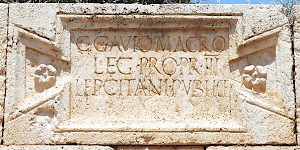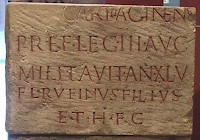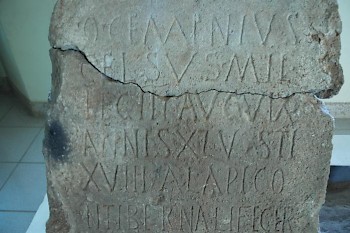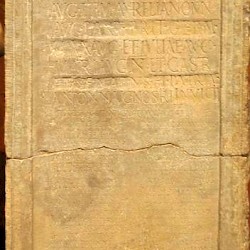Legio III Augusta
Legio III Augusta: one of the Roman legions. Its name means "the legion of Augustus", but contains a pun on "august legion". It was Rome's main garrison in Africa.

This legion was probably recruited by consul Gaius Vibius Pansa and Octavian (the later emperor Augustus) in 43 BCE. It may have been present during the battle of Philippi (42), in which the triumvirs Octavian and Mark Antony defeated the murderers of Caesar.
It is likely that in the next years, the Third legion took part in the war that Octavian and Lepidus waged against Sextus Pompeius, who had occupied Sicily and threatened the food supply of Rome. When Octavian had won this war, he attacked Lepidus, and took his province, Africa (36). It is possible that the legion was sent to this region after this conflict.
However this may be, it is certain that from 30 BCE on, the Third was permanently in Africa, although it was not always stationed in the same camp. An inscription from 14 CE informs us that the soldiers had to build a road from Tacapsa to their winter quarters, which may at this stage have been at Theveste.

Although Africa was usually a tranquil part of the Roman empire, III Augusta saw action in 17-24, when it fought against Tacfarinas, who had organized several Numidian and Mauretanian tribes in an anti-Roman coalition. Perhaps this war was the cause of the legion's transfer to Ammaedara.
After Tacfarinas had been defeated by the governor of Africa, Marcus Furius Camillus, in a regular battle in 17, he launched a guerilla, which was the type of war the Romans least understood. In 18, a subunit of III Augusta was annihilated, and the new commander, Lucius Apronius, punished the legionaries according to an ancestral custom: decimation, i.e. the killing of every tenth soldier. In 21, VIIII Hispana was sent to help III Augusta. Still, the war lasted four more years, until governor Junius Blaesus defeated Tacfarinas. The Ninth was recalled, but immediately, Tacfarinas returned. However, the Third Augustan legion was now able to overcome its enemy. The rebel committed suicide in 24.

In this period, the Third was the only legion in the Roman empire that was commanded by a senator: the proconsul (governor) of Africa. One of them may have been Velleius Paterculus, who is better known as the author of a short Roman History. This is based on the interpretation of an inscription that may be read in another way.note
The emperor Caligula (r.37-41) thought that it was risky to leave a legion in the hands of a senator, and saw to it that the commander of III Augusta was one of his appointees (a legatus Augusti pro praetore). His successors Claudius and Nero stuck to this policy, although it is possible that Sulpicius Galba (the future emperor) had the traditional powers in 45-46, when he fought against the local tribes.

During the confused last years of the reign of Nero, the legion's commander Lucius Clodius Macer was one of those who revolted against the tyrannical despot. He recruited another legion, I Macriana Liberatrix, and supported Sulpicius Galba, who became emperor in 69. But the new ruler distrusted Macer and ordered the procurator Trebonius Garutianus to kill the commander of the two legions.
In January 69, Galba lost control of the situation. He was killed, and civil war broke out between Otho and Vitellius, a former governor of Africa. III Augusta sided with him, but did not see battle. At the end of the year, the legion went over to another pretender, Vespasian, who was able to bring peace to the empire. He was also responsible for the transfer from Ammaedara to Theveste (75).
From the age of the emperor Hadrian (r.117-138) a famous inscription from this site is one of our most important pieces of evidence about the Roman legions, we find III Augusta at Lambaesis in Numidia. It had already been occupied (in 81?) by a subunit or an auxilary unit, but now became a huge military settlement. Veterans were settled in Cuicul, Sitifis, and Thamugadi.

With an interruption of fifteen years, whcih we will discuss in a moment, the Third was to stay here for almost two centuries, guarding the empire against Berber tribes. At times, these nomads could be very dangerous. The war against the Moors during Antoninus Pius (r.138-161) lasted a long time.
Sometimes, legionaries were sent to other provinces. It is known that in 115, subunits were sent to Syria and joined the emperor Trajan in his war against the Parthian empire. There were many casualties, and Syrians were recruited to reinforce III Augusta. (Their tombstones have been found at Lambaesis.) Between 132 and 136, a large subunit served in the war against Bar Kochba, a messianic claimant in Judaea. Some thirty years later, subunits took part in the Parthian campaign of Lucius Verus. In 215-217, Caracalla used legionaries from Lambaesis during his eastern war.

In 175, legionaries of III Augusta took part in the Marcomannic campaign of Marcus Aurelius, which brought the African soldiers to Hungary. Many of them never returned because they were transferred to II Adiutrix, a legion that had suffered heavily during this war. A similar incident had taken place in 126, when III Augusta sent soldiers to reinforce either III Cyrenaica of III Gallica.
The emperor Lucius Septimius Severus, an African, awarded the legion the title Pia Vindex ("Faithful avenger") in 193. This suggests that III Augusta played a role in the civil war after the murder of the emperor Publius Helvius Pertinax, but we have no further evidence for this.

Severus also ordered the construction of a series of forts along the desert frontier, like Ghadames, Gheriat el-Garbia, and Bu Njem (the Limes Tripolitanus). Like Lambaesis, they have survived and have an architectural oddity: the pentagonal towers near the gates. They are unique for buildings by III Augusta.
It seems that during the reign of Caracalla (r.211-217), Macrinus (r.217-218) or early in the reign of Heliogabalus (r.218-222), the Third suffered losses against a desert tribe. It was reinforced by soldiers from III Gallica, which had been disbanded by Heliogabalus.

In 238, the governor of Africa used this legion to suppress the rebellion of Gordian I and Gordian II, who had become emperors. Although they revolt was not successful, the civil war, which saw no less than seven emperors in one year, was won by their descendant Gordian III, who disbanded the legion.
Fifteen years later, the emperor Valerian reconstituted this unit and gave it the title Iterum Pia Iterum Vindex ("Again faithful, again avenger"). The refounded Third Augustan legion now fought a long and difficult war against the "Five peoples", a dangerous federation of Berber tribes. The struggle lasted until about 260, when commander Gaius Macrinus Decianus erected a victory monument at Lambaesis.
That the situation was not really safe can be deduced from the fact that this military settlement was fortified in the years after this victory. In 289-297, the struggle was renewed, and the emperor Maximianus was forced to take personal command of the Roman forces in Africa and Numidia.
The title Pia Fidelis may have been given by the emperor Diocletian, who at the beginning of the fourth century personally led a war against a rebel governor. Immediately after the victory, III Augusta left Lambaesis, and although it stayed in the region, we do not know where. The legion is still mentioned in the late fourth or early fifth century, including a Christian soldier buried in Madauros.
Among the emblems of the legion was probably the winged horse Pegasus. The Capricorn is also attested.
Literature
- M. Christol, "Sur quelques centurions de la legion III Augusta", in Zeitschrift für Papyrologie und Epigraphik 103 (1994)
- Y. Le Bohec, La IIIe Légion Auguste (1989 Paris)
- Y. Le Bohec, "Legio III Augusta", in: Yann Le Bohec, Les légions de Rome sous le Haut-Empire (2000 Lyon) 373-381
- Jona Lendering, "Hadrian and his Soldiers. The Lambaesis Inscription", in: Core of the Legions. The Roman Imperial Centuria = Ancient Warfare Special 2010)
 Madauros, Inscription referring to a Christian soldier of III Augusta |
 Lambaesis, Rules for the trumpetters of III Augusta |